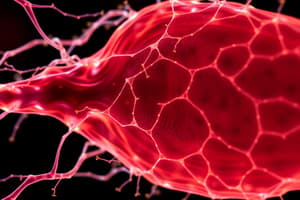Podcast
Questions and Answers
What is the primary function of cell movement in an embryo?
What is the primary function of cell movement in an embryo?
- Migration for developmental processes (correct)
- Formation of chemical signals
- Energy production
- Cell growth and replication
Which protein is NOT involved in cell movement?
Which protein is NOT involved in cell movement?
- Myosin
- Kinesin
- Dynein
- Keratin (correct)
What role do microtubules play in the cell?
What role do microtubules play in the cell?
- Cell motility and transport (correct)
- Energy storage
- Chemical metabolism
- Protein synthesis
How many protofilaments compose a single microtubule in mammals?
How many protofilaments compose a single microtubule in mammals?
What is a primary function of intermediate filaments?
What is a primary function of intermediate filaments?
What is the composition of cilia and eukaryotic flagella?
What is the composition of cilia and eukaryotic flagella?
In adults, what is one of the critical roles of cell migration?
In adults, what is one of the critical roles of cell migration?
What is the largest type of filament in the cytoskeleton?
What is the largest type of filament in the cytoskeleton?
What type of cell movement is primarily involved in the development of multicellular embryos?
What type of cell movement is primarily involved in the development of multicellular embryos?
Which of the following is NOT a function of microtubules?
Which of the following is NOT a function of microtubules?
What are the two basic mechanisms for cell movement that involve ATP?
What are the two basic mechanisms for cell movement that involve ATP?
Intermediate filaments primarily provide which type of strength to cells?
Intermediate filaments primarily provide which type of strength to cells?
Cilia and eukaryotic flagella share a common structural composition. What is their core structure primarily made up of?
Cilia and eukaryotic flagella share a common structural composition. What is their core structure primarily made up of?
Which specialized proteins are responsible for cell movement along microtubules?
Which specialized proteins are responsible for cell movement along microtubules?
What can uncontrolled cell migration indicate within the context of human health?
What can uncontrolled cell migration indicate within the context of human health?
Which statement describes an essential aspect of cell movement in adults?
Which statement describes an essential aspect of cell movement in adults?
The cytoskeleton consists of various components. Which of the following is NOT one of its standard components?
The cytoskeleton consists of various components. Which of the following is NOT one of its standard components?
How do cilia function in a multicellular organism?
How do cilia function in a multicellular organism?
Flashcards
Cell Movement
Cell Movement
The ability of cells to change position or shape within tissues or in response to external stimuli.
Cell Movement Importance
Cell Movement Importance
Essential for processes like embryo development, adult tissue repair, and immune responses.
Cell Movement Mechanisms (ATP)
Cell Movement Mechanisms (ATP)
Cells move using motor proteins (kinesin/dynein) and microtubules. Actin microfilaments and myosin motor molecules are another pathway.
Cytoskeleton Components
Cytoskeleton Components
Signup and view all the flashcards
Microtubules Function
Microtubules Function
Signup and view all the flashcards
Cilia and Flagella Movement
Cilia and Flagella Movement
Signup and view all the flashcards
Cilia and Flagella Composition
Cilia and Flagella Composition
Signup and view all the flashcards
Intermediate Filaments
Intermediate Filaments
Signup and view all the flashcards
Why is Cell Movement Important?
Why is Cell Movement Important?
Signup and view all the flashcards
Cell Migration in Embryos
Cell Migration in Embryos
Signup and view all the flashcards
Cell Migration in Adults
Cell Migration in Adults
Signup and view all the flashcards
Uncontrolled Cell Migration
Uncontrolled Cell Migration
Signup and view all the flashcards
What are the ATP-dependent mechanisms of cell movement?
What are the ATP-dependent mechanisms of cell movement?
Signup and view all the flashcards
What is the Cytoskeleton Made Of?
What is the Cytoskeleton Made Of?
Signup and view all the flashcards
How do Cilia and Flagella Move?
How do Cilia and Flagella Move?
Signup and view all the flashcards
Study Notes
Cell Movement and Function
- Cell movement is the ability of cells to alter their position or shape, vital for tissue growth & differentiation.
- Crucial in multicellular organisms for embryonic development, adult tissue repair, and immune response to pathogens.
- Uncontrolled cell movement can signify cancer.
Mechanisms of Cell Movement
- Cell movement employs ATP-dependent mechanisms:
- Specialized motor proteins (kinesins & dyneins) interacting with microtubules.
- Actin microfilaments and myosin motor molecules.
Cytoskeleton Structure
- The cytoskeleton is composed of microtubules, actin filaments, and intermediate filaments.
Microtubules
- Microtubules (MTs) are the largest cytoskeletal filaments.
- Functions: mitosis, cell motility, intracellular transport, maintaining axons and cell form.
- Found in all eukaryotic cells.
Protofilaments
- Protofilaments are components of microtubules.
- A singlet microtubule in mammals is composed of 13 protofilaments.
Intermediate Filaments
- Keratin is an essential protein for animal structures (hair, skin, nails, horns).
- Primarily provides mechanical strength to cells, supporting against stress.
- Less dynamic than actin filaments or microtubules.
- Often work with microtubules for strength & support.
Cilia and Flagella
- Cilia and flagella, involved in cell movement, stem from specialized microtubule groupings—basal bodies.
- Composed of microtubules anchored to the plasma membrane.
- Function in fluid movement past cell surfaces (e.g., for water flow).
- In single-celled organisms, they are used for locomotion (e.g., sperm).
Studying That Suits You
Use AI to generate personalized quizzes and flashcards to suit your learning preferences.



